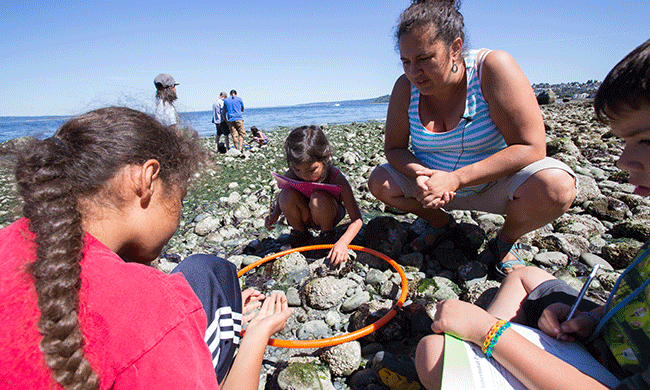The Importance of Training Teachers to Better Understand Their Native Students
Native students have the highest dropout rates, but a college program for educators aims to change that.By Bailey Williams
YES! Magazine
yesmagazine.org Native American students make up 1.4 percent of the students in Washington state public schools. And they have the lowest graduation rate of any ethnic group, with just 56.4 percent earning a high school diploma in four years. “I was that young person, I dropped out of school. I was one of those statistics of Native women dropouts,” says Dawn Hardison-Stevens, who is a member of the Steilacoom Tribal Council. Hardison-Stevens, who at the time was a young mother with a 3-year-old and a newborn, says that a school counselor convinced her to get a high school diploma rather than just a GED. That extra push led her to pursue college, then graduate school, and then eventually to where she is today—working as program manager of the Native Education Certificate Program at the University of Washington. The program offers professional development for non-Native teachers, administrators, and other educators who work in Native American communities, including on the 29 Indian reservations in Washington. Understanding the culture of the people they’re teaching and their environment makes for better teachers, says Megan Bang, the program’s co-founder and director and a professor in the UW’s College of Education. Bang, who is of Ojibwe descent, says that Native people tend to be more interdependent than independent. “Much of mainstream education is very focused on ‘I’ and individualism,” she says. “And in many Native communities that is not how it is focused. It’s much more on the collective and many times the way things are framed in school are disengaging and unmotivating for kids.”

Hardison-Stevens says that this program “brings forth authentic and honest information from Native perspectives.” She says it’s about bringing that awareness because “you don’t know what you don’t know.” The program had its origins in a request from tribal leaders to the university: “Please take up some of the responsibility around the problems of education in Native communities in Washington state,” Bang says. That first request was made 12 years ago, but the program launched recently in the summer of 2016. “Native kids are not seen as a high priority, and that tends to be the case at universities, as well,” Bang says. “There’s kind of an invisibility problem that happens. That sometimes means that mainstream communities don’t prioritize work with Native people.” Bang conducted a series of focus groups in different tribal communities leading up to the program launch. It’s taught as a hybrid class, with most of the instruction being done over the internet while many assignments are conducted hands-on in Native communities across the state. “We ask our teachers to go and do interviews with kids, families, and community members about their units, their challenges, and the way that they wish the way schools were going,” Bang says. Bang says that having an online class has its benefits. “What it allows us to do is reach communities and places that don’t get professional development opportunities like this in a way that we would never be able to do otherwise,” she says. At the end of the program the students are required to design a project that brings forth what they learned in a “community-specific way,” Bang says. It may be revising curriculum for a teacher or rethinking how the school board involves and engages the Native community. The projects are variable and depend on what community area the students want to focus on. “The projects are intended to be things that set a permanent change in motion, which means their projects are about something they’re going to sustain over multiple years,” says Bang. Bailey Williams wrote this article for YES! Magazine. Bailey is a solutions reporting intern for YES! Magazine. She is a journalist from Des Moines, Washington, who is passionate about intersectional feminism, social justice, and ending violence against people of color. Follow her on Twitter @Baileyninaw. Note: This article originally appeared on YES! Magazine. It is published under a Creative Commons license.
Join the Conversation

